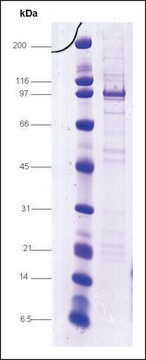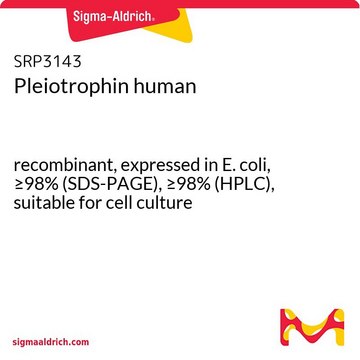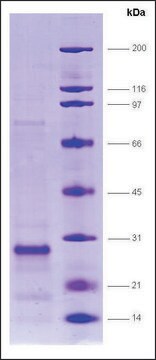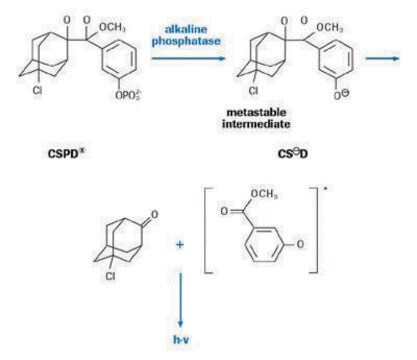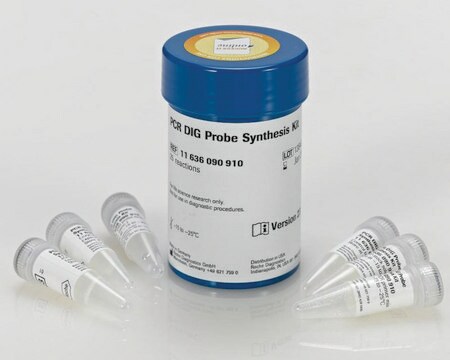SRP2029
Sp1 GC-box binding protein human
≥70% (SDS-PAGE)
Faça loginpara ver os preços organizacionais e de contrato
About This Item
Código UNSPSC:
12352202
NACRES:
NA.26
Produtos recomendados
fonte biológica
human
Ensaio
≥70% (SDS-PAGE)
Formulário
frozen liquid
peso molecular
~80.7 kDa
embalagem
pkg of 2 μg
condição de armazenamento
avoid repeated freeze/thaw cycles
concentração
100 μg/mL
técnica(s)
electrophoretic mobility shift assay: suitable
cor
clear colorless
nº de adesão NCBI
nº de adesão UniProt
Condições de expedição
dry ice
temperatura de armazenamento
−70°C
Informações sobre genes
human ... SP1(6667)
Descrição geral
Specific protein 1 (Sp1) is a transcription regulator that has a transactivation domain at the N-terminus and a DNA-binding domain at the C-terminus, that contain three zinc fingers (ZF). This transcription factor selectively binds to the hexanucleotide sequence, GGGCGG (GC-box). It belongs to transcription factor family and is located on human chromosome 12q13.
Ações bioquímicas/fisiológicas
Sp1 was first detected in HeLa cells on the basis of its ability to activate the SV40 early promoter transcription. Subsequently it was shown to recognize and bind selectively to a GC-rich consensus sequence (GC-box: GGGCGG or CACCC) that presents in the promoter of several important cellular genes, including SV40 early, HIV-1, PDGF-B etc. Sp1 was the first transcription factor to be cloned. Analysis of structure and function has revealed that Sp1 can be separated into discrete functional domains. The DNA-binding domain consists of three zinc fingers that specifically bind to the GC-box element. Sp1 contains at least four separate transcriptional activation domains. Two of these domains are glutamine-rich, a well-characterized motif found in several other transcription factors. In addition to transcription, Sp1 function has been linked to cell growth, cancer, Huntington disease and other disorders through transcriptional regulation or specific protein-protein interactions. The function of Sp1 can be regulated by phosphorylation and glycosylation.
Specific protein 1 (Sp1) controls the up- and down-regulation of hCtr1 (human high-affinity copper transporter 1). It controls the expression of several genes that participates in differentiation, cell cycle and oncogenesis.It has the ability to bind GC/GT-rich promoter elements with the help of C(2)H(2)-type zinc fingers at the C-terminal domains.
forma física
Clear and colorless frozen liquid solution
Nota de preparo
Use a manual defrost freezer and avoid repeated freeze-thaw cycles. While working, please keep sample on ice.
Código de classe de armazenamento
10 - Combustible liquids
Classe de risco de água (WGK)
WGK 1
Ponto de fulgor (°F)
Not applicable
Ponto de fulgor (°C)
Not applicable
Escolha uma das versões mais recentes:
Certificados de análise (COA)
Lot/Batch Number
Não está vendo a versão correta?
Se precisar de uma versão específica, você pode procurar um certificado específico pelo número do lote ou da remessa.
Já possui este produto?
Encontre a documentação dos produtos que você adquiriu recentemente na biblioteca de documentos.
An insight into the phylogenetic history of HOX linked gene families in vertebrates
Abbasi AA and Grzeschik KH
BMC Evolutionary Biology (2007)
New insights into the multiple functions of Spl, a ubiquitous transcription factor.
Parnaik V K
Current Science, 76(2), 166-172 (1999)
MiR-24 enhances radiosensitivity in nasopharyngeal carcinoma by targeting SP1
Kang M, et al.
Cancer Medicine, 5(6), 1163-1173 (2016)
Sp1 and Sp3 function as key regulators of leukotriene C(4) synthase gene expression in the monocyte-like cell line, THP-1.
Serio KJ et al
American Journal of Respiratory Cell and Molecular Biology, 23(2), 234-240 (2000)
Effects of Cu(II) and cisplatin on the stability of Specific protein 1 (Sp1)-DNA binding: Insights into the regulation of copper homeostasis and platinum drug transport
Yan D, et al.
Journal of Inorganic Biochemistry, 161, 37-39 (2016)
Nossa equipe de cientistas tem experiência em todas as áreas de pesquisa, incluindo Life Sciences, ciência de materiais, síntese química, cromatografia, química analítica e muitas outras.
Entre em contato com a assistência técnica